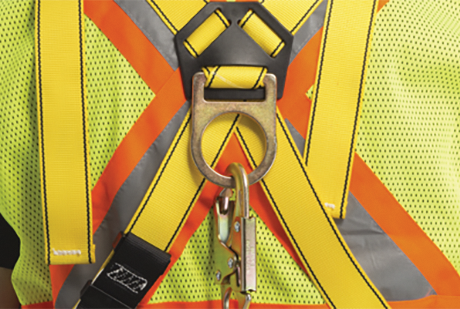NRCA introduces new fall-protection training course

|
To help safety professionals comply with Occupational Safety and Health Administration and other requirements and understand the latest fall-protection techniques, NRCA now offers an in-person, interactive training course.
NRCA’s three-day, roofing-specific Fall Protection Competent Person Training is designed for foremen crew leaders, safety directors and NRCA Qualified Trainers. Participants will learn the latest information about fall hazard recognition (including job hazard analysis); fall-protection system specifications and limitations; detailed inspection protocols for fall-protection equipment and roof deck integrity; self-rescue and assisted rescue from an arrested fall; and effective training techniques.
Additional information is available at nrca.net/education/custom-education/fall-protection-competence.
Safety tips to help prevent drop hazards

|
Performing overhead construction work poses significant safety concerns, and it is important to know how to prevent drop hazards, such as falling tools, according to constructionexec.com. The Occupational Safety and Health Administration includes the risk of being struck by a falling object as one of the “fatal four” leading causes of injury and death resulting from a construction-related accident.
Anyone on a construction site is at an increased risk for injury from dropped tools when the following conditions are present: overhead work; scaffolds; cranes; use of power tools; ladders; lifting operations; elevated platforms; performing tasks that require force (pulling, pushing, prying, etc.); and portable equipment put together on-site.
Taking preventive action can help alleviate risks related to drop hazards. Following are some tips to increase safety on job sites.
- Mandate safety equipment. Require hard hats and eyewear to be worn by every person at risk for falling objects. This includes construction workers, managers, property managers and visitors.
- Use barricades or ropes to mark off areas where potential drop hazards exist.
- Use toe boards and screens, ensuring they are secure in place by having them inspected before use.
- Implement the use of shock-absorbing tool lanyards that attach directly to workers to reduce drop risk. Note: This only applies to tools light enough that they would not pull a worker down if they are dropped.
- Practice good housekeeping and maintenance by keeping tools and other materials away from edges or elevated surfaces.
- Always secure tools and materials to prevent movement from external factors, such as weather.
- Require risk assessments before conducting work with drop hazards to help prevent a potential accident.
- Remove excess hazards. Mandating that workers at height only bring the tools required to perform their jobs will minimize the probability of a tool being dropped.
Assess potential job candidates to avoid harmful consequences

|
Labor shortages often increase the burden on existing staff members, creating the potential for dissatisfaction, burnout and more vacancies. However, the temptation to hire anyone willing to take the job could have potentially harmful consequences, according to Harvard Business Review.
If hiring no one or hiring “just anyone” can be harmful, it’s important to know how to assess candidates and decide whether to take a chance on a candidate or keep a position vacant until a more appropriate candidate is found.
Harvard Business Review identifies four traits that most significantly affect a team.
- Reliability. Use reference-checking skills to try to screen out unreliable workers. Make sure the interview includes behavioral questions that might provide clues, such as asking how the candidate managed an unexpected event; generally, adaptable and resilient individuals are more likely to be reliable.
- Job readiness. If employees are overworked, some help may be better than no help—assuming the new hire requires minimal training. Beyond task-specific skills, look for candidates with a growth mindset because they believe knowledge and abilities can be developed with effort.
- A positive attitude. Many employees will change their task workflow to avoid someone negative and difficult. This can affect other employees, who end up accomplishing less work and becoming more dissatisfied.
- Good communication. Being able to communicate well with colleagues is important in any work environment, and for projects that require professionals with different areas of expertise to work together, one individual can derail the whole team. Managers can assess basic communication skills during an interview by looking for clarity and coherence of responses. They also could consider asking the candidate about his or her preferred communication medium to see how it fits with the team’s communications.
In the meantime, it is crucial a manager respects, gives attention to and rewards current employees, as well as reassures them the company is looking for someone who would be a good co-worker.
Owens Corning will expand capacity to meet growing demand
Owens Corning, Toledo, Ohio, has announced plans to accelerate increased production capabilities to support growing demand for its roofing products.
The company’s plans for 2022-23 include a multimillion-dollar investment that will increase capacity across its shingle plant network, adding the equivalent of a full shingle line to its shingle production capability.
Owens Corning also will make significant investments in increased inventory levels and warehousing to meet demand surges during peak seasons.
Additionally, the company will expand its fiberglass mat facility in Fort Smith, Ark., which will significantly increase its mat capacity starting in 2023.
The investments also will increase the company’s production capacity in roofing accessory products.



